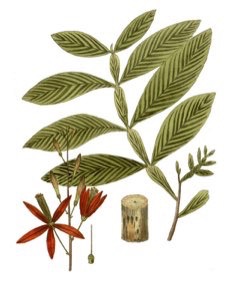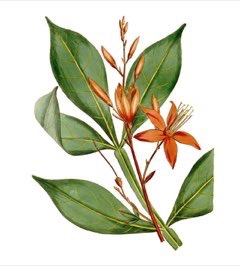 |
|
http://www.edibleplants.org |
 |
| http://www.edibleplants.org |
Translate this page:
Summary
Quassia amara or commonly known as Bitterwood or Amargo is a small evergreen shrub growing only about 3 m in height. It bears a small drupe, red flowers, and compound, alternate leaves. Though it is mainly cultivated throughout Northern South America as an ornamental tree, it is also valued for its edible and medicinal uses. In particular, bark extracts are used as flavoring in drinks. Medicinally, all plant parts are useful. It restores appetite, stimulates digestion, and treats various conditions such as fever, measles, malaria, diarrhea, dysentery, urinary tract disease, liver cirrhosis, alcoholism, diabetes, albuminuria, ulcers, smallpox, etc. Propagation can be through seeds and cuttings.
Physical Characteristics

 Quassia amara is an evergreen Shrub growing to 5 m (16ft) by 5 m (16ft) at a slow rate.
Quassia amara is an evergreen Shrub growing to 5 m (16ft) by 5 m (16ft) at a slow rate.
See above for USDA hardiness. It is hardy to UK zone 10 and is frost tender. The flowers are pollinated by Hummingbirds.
Suitable for: medium (loamy) and heavy (clay) soils. Suitable pH: mildly acid, neutral and basic (mildly alkaline) soils. It can grow in semi-shade (light woodland) or no shade. It prefers moist soil.
UK Hardiness Map
US Hardiness Map
Synonyms
Quassia alatifolia Stokes Quassia officinalis Rich.
Plant Habitats
Edible Uses
Edible Parts: Inner bark
Edible Uses: Drink
The bitter principle found in the bark and wood is used as the basis of Angostura Bitters, which is used as a flavouring in gin-based drinks[307 ]. It is also used as a substitute for hops when brewing beer[301 ].
References More on Edible Uses
Medicinal Uses
Plants For A Future can not take any responsibility for any adverse effects from the use of plants. Always seek advice from a professional before using a plant medicinally.
Antidiarrhoeal Antitumor Appetizer Astringent Blood purifier Cancer Digestive Dysentery
Febrifuge Laxative Malaria Mouthwash Odontalgic Ophthalmic Parasiticide
Skin Tonic Urinary Vermifuge
All parts of the plant contain a bitter principle called quassimarin[307 ]. This has a range of medical properties including antileukaemic, antitumor, astringent, digestive, febrifuge, laxative, tonic and vermifuge[307 ]. Quassimarin has been shown to stimulate the secretion of gastric juices, increase the appetite and aid digestion[307 ]. It has been used successfully in the treatment of anorexia nervosa and is also used in the treatment of malaria and fevers[307 , 348 ]. All parts of the plant can be used on their own or in combination to restore the appetite, stimulate digestion and combat fevers, including malaria[348 ]. A tea made from the infused leaves is used to bathe the skin of measles patients[307 ]. It is also used as a mouthwash after tooth extractions[307 ]. A decoction of the bark is used as a blood purifier and to treat malaria, diarrhoea and dysentery[348 ]. A decoction of the inner bark is used to treat colds[348 The stem and bark are used in remedies for treating diseases of the spleen, liver (cirrhosis), and urinary tract[348 ]. The bark is used for treating the weak eyes of alcoholics and, macerated in rum, as a vermifuge[348 ]. Combined with the macerated stem of Tinospora crispa in rum, cognac or absinthe, it is used to make a beverage for treating diabetes and albuminuria[348 ]. A decoction of the wood is used in lotions as a wash for persistent venereal ulcers[348 ]. A decoction of the bark and leaves is used as a wash to rid the skin of external parasites such as agouti lice and as a treatment for measles and smallpox[348 ]. Stem-bark contains the insecticidal compounds neoquassine and quassine[348 ]. Sap shows activity against cells derived from carcinoma of human nasopharynx[348 ]. Plant extracts contain the antileukemic compounds quassimarin and similikalactone[348 ].
References More on Medicinal Uses
The Bookshop: Edible Plant Books
Our Latest books on Perennial Plants For Food Forests and Permaculture Gardens in paperback or digital formats.

Edible Tropical Plants
Food Forest Plants for Hotter Conditions: 250+ Plants For Tropical Food Forests & Permaculture Gardens.
More

Edible Temperate Plants
Plants for Your Food Forest: 500 Plants for Temperate Food Forests & Permaculture Gardens.
More

More Books
PFAF have eight books available in paperback and digital formats. Browse the shop for more information.
Shop Now
Other Uses
Houseplant Insecticide Parasiticide
Humid shade garden. large container. Accent. Botanic collection. Conservatory. Other Uses: All parts of the plant, but especially the bark and young stems, can be used as an insecticide[307 ]. Crushed leaves, placed on body, reputedly act as a mosquito repellent[348 ].
Special Uses
References More on Other Uses
Cultivation details
A plant for the humid tropics[200 ]. Prefers a fertile, moist but well-drained soil in a partially shaded position[302 , 307 ]. Bloom Color: Scarlet (Dark Red). Spacing: over 40 ft. (12 m).
References Carbon Farming Information and Carbon Sequestration Information
Temperature Converter
Type a value in the Celsius field to convert the value to Fahrenheit:
Fahrenheit:
The PFAF Bookshop
Plants For A Future have a number of books available in paperback and digital form. Book titles include Edible Plants, Edible Perennials, Edible Trees,Edible Shrubs, Woodland Gardening, and Temperate Food Forest Plants. Our new book is Food Forest Plants For Hotter Conditions (Tropical and Sub-Tropical).
Shop Now
Plant Propagation
Seed - Cuttings of half-ripe wood
Other Names
If available other names are mentioned here
Hombre grande, Kwasibita, Asoemaripa, amargo, bitterholz, bitterholzbaum, bitterquassia, bitterwood, bois amer, crucete, cuasia, cuasia amarga, hombre grande, jamaica quassia, kvassia, kwasi beta|weradi sinchona, pau-amarelo, pau-amargo, pau-quássia, quassia, quassia amara, quassia de surinam, quassia surinam, quassia-wood, quassiae lignum, quassiaholzbaum, quassie, quina, quinarana, quinine de cayenne, quinine du pays, quássia-de-caiena, su, surinam quassia, wéwe gífi.
Native Range
SOUTHERN AMERICA: Trinidad and Tobago (Trinidad), Costa Rica, Nicaragua, Panama, French Guiana, Guyana, Suriname, Venezuela, Brazil, Colombia
Weed Potential
Right plant wrong place. We are currently updating this section.
Please note that a plant may be invasive in one area but may not in your area so it's worth checking.
Conservation Status
IUCN Red List of Threatened Plants Status : This taxon has not yet been assessed

Growth: S = slow M = medium F = fast. Soil: L = light (sandy) M = medium H = heavy (clay). pH: A = acid N = neutral B = basic (alkaline). Shade: F = full shade S = semi-shade N = no shade. Moisture: D = dry M = Moist We = wet Wa = water.
Now available:
Food Forest Plants for Mediterranean Conditions
350+ Perennial Plants For Mediterranean and Drier Food Forests and Permaculture Gardens.
[Paperback and eBook]
This is the third in Plants For A Future's series of plant guides for food forests tailored to
specific climate zones. Following volumes on temperate and tropical ecosystems, this book focuses
on species suited to Mediterranean conditions—regions with hot, dry summers and cool, wet winters,
often facing the added challenge of climate change.
Read More
Expert comment
Author
L.
Botanical References
Links / References
For a list of references used on this page please go here
A special thanks to Ken Fern for some of the information used on this page.
Readers comment
| Add a comment |
|
If you have important information about this plant that may help other users please add a comment or link below. Only comments or links that are felt to be directly relevant to a plant will be included. If you think a comment/link or information contained on this page is inaccurate or misleading we would welcome your feedback at [email protected]. If you have questions about a plant please use the Forum on this website as we do not have the resources to answer questions ourselves.
* Please note: the comments by website users are not necessarily those held by PFAF and may give misleading or inaccurate information.
To leave a comment please Register or login here All comments need to be approved so will not appear immediately.
|
|